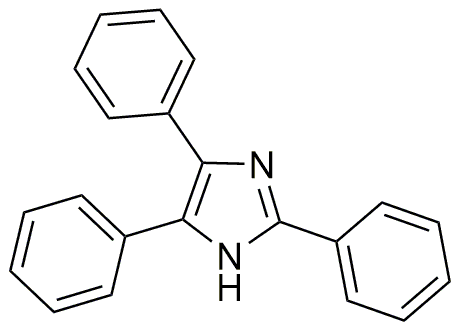2,4,5-Triphenylimidazole is widely utilized in research focused on:
- Photovoltaic Applications: This compound is used in the development of organic solar cells, enhancing their efficiency by acting as a light-absorbing material.
- Chemical Sensors: It serves as a key component in chemical sensors, particularly for detecting environmental pollutants, due to its ability to interact selectively with specific substances.
- Pharmaceutical Development: Researchers leverage its properties in drug formulation, particularly in designing compounds that target specific biological pathways, improving therapeutic efficacy.
- Polymer Chemistry: It is incorporated into polymer matrices to improve thermal stability and mechanical properties, making it valuable in materials science.
- Fluorescent Dyes: The compound is utilized in creating fluorescent dyes for biological imaging, aiding in the visualization of cellular processes in research settings.
Informations générales
Propriétés
Sécurité et réglementation
Applications
2,4,5-Triphenylimidazole is widely utilized in research focused on:
- Photovoltaic Applications: This compound is used in the development of organic solar cells, enhancing their efficiency by acting as a light-absorbing material.
- Chemical Sensors: It serves as a key component in chemical sensors, particularly for detecting environmental pollutants, due to its ability to interact selectively with specific substances.
- Pharmaceutical Development: Researchers leverage its properties in drug formulation, particularly in designing compounds that target specific biological pathways, improving therapeutic efficacy.
- Polymer Chemistry: It is incorporated into polymer matrices to improve thermal stability and mechanical properties, making it valuable in materials science.
- Fluorescent Dyes: The compound is utilized in creating fluorescent dyes for biological imaging, aiding in the visualization of cellular processes in research settings.
Documents
Fiches de données de sécurité (FDS)
La FDS fournit des informations de sécurité complètes sur la manipulation, le stockage et l’élimination du produit.
Spécifications du produit (PS)
Le PS fournit une description complète des propriétés du produit, notamment sa composition chimique, son état physique, sa pureté et les exigences de stockage. Il détaille également les plages de qualité acceptables et les applications prévues du produit.
Certificats d'analyse (COA)
Recherchez des certificats d'analyse (COA) en saisissant le numéro de lot du produit. Les numéros de lot et de lot se trouvent sur l'étiquette d'un produit, après les mots « Lot » ou « Lot de fabrication ».
Numéro de catalogue
Numéro de lot/série
Certificats d'origine (COO)
Ce certificat d'exploitation confirme le pays dans lequel le produit a été fabriqué, et détaille également les matériaux et composants utilisés et s'il est issu de sources naturelles, synthétiques ou autres sources spécifiques. Ce certificat peut être requis pour les douanes, le commerce et la conformité réglementaire.
Numéro de catalogue
Numéro de lot/série
Fiches de données de sécurité (FDS)
La FDS fournit des informations de sécurité complètes sur la manipulation, le stockage et l’élimination du produit.
DownloadSpécifications du produit (PS)
Le PS fournit une description complète des propriétés du produit, notamment sa composition chimique, son état physique, sa pureté et les exigences de stockage. Il détaille également les plages de qualité acceptables et les applications prévues du produit.
DownloadCertificats d'analyse (COA)
Recherchez des certificats d'analyse (COA) en saisissant le numéro de lot du produit. Les numéros de lot et de lot se trouvent sur l'étiquette d'un produit, après les mots « Lot » ou « Lot de fabrication ».
Numéro de catalogue
Numéro de lot/série
Certificats d'origine (COO)
Ce certificat d'exploitation confirme le pays dans lequel le produit a été fabriqué, et détaille également les matériaux et composants utilisés et s'il est issu de sources naturelles, synthétiques ou autres sources spécifiques. Ce certificat peut être requis pour les douanes, le commerce et la conformité réglementaire.


